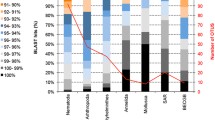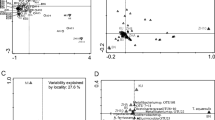Abstract
The next generation sequencing (NGS) tools available today, i.e., 454 Roche pyrosequencing (Shendure and Ji 2008) allow metagenomic studies on the composition and structure of microbial communities in a way that it was not possible before (Handelsman 2004). In the field of macroecology, early studies showed that fresh water and marine benthic invertebrate communities varied in their structure, i. e., number of species (species richness) and relative abundance among species (dominance or lack of it) (Thienemann 1939; Sanders 1968). From their work, we here construct the “Thienemann-Sanders time-stability (TS2) hypothesis” which predicts that the older and more stable the habitat the higher the species richness and diversity with a lack of dominance by any member in the community. The contrary would be the case in younger and/or drastically varying habitats. The former conditions would render a “biologically accommodated” community while the latter a “physically controlled” community. Ward et al. (1998) suggested that: “By adopting the view of macroecologists and macroevolutionary biologists as they interpret their findings, microbial ecologists can see if unifying principles control the diversity, ecology, and evolution of all organisms, large and small”. The question thus is: Does the “TS2 hypothesis” fit prokaryotic communities? As a test, here we show the results of the analysis of relative operational taxonomic unit (OTU=species proxies) abundance data of benthic bacteria from the Humboldt Sulfuretum (HS). The analysis disclosed high values of species richness, a lack of dominants, high information diversity indices, and steep rarefaction curves, all features pointing to an evolutionarily mature, “biologically accommodated” community consistent with the TS2 hypothesis. Thus, this study suggests that bacterial communities of old environments such as a sulfuretum comply with macroecologically-derived principles.




Similar content being viewed by others

References
Baas-Becking L (1925) Studies on the Sulphur Bacteria. Ann Botany os-39:613–650
Brazelton WJ et al (2010) Archaea and bacteria with surprising microdiversity show shifts in dominance over 1,000-year time scales in hydrothermal chimneys. Proc Natl Acad Sci U S A 107:1612–1617. doi:10.1073/pnas.0905369107
Chao A (1984) Nonparametric estimation of the number of classes in a population. Scand J Stat 11:265–270
Chen W, Zhang CK, Cheng Y, Zhang S, Zhao H (2013) A Comparison of Methods for Clustering 16S rRNA Sequences into OTUs. PLoS ONE 8(8), e70837. doi:10.1371/journal.pone.0070837
Clarke K, Gorley R (2006) PRIMER v6: User Manual/Tutorial PRIMER-E. Plymouth
R Core Team (2014) R: A language and environment for statistical computing. R Foundation for Statistical Computing, http://www.R-project.org/
Daneri G, Dellarossa V, Quiñones R, Jacob B, Montero P, Ulloa O (2000) Primary production and community respiration in the Humboldt Current System off Chile and associated oceanic areas. Mar Ecol-Prog Ser 197:41–49
Fossing H et al (1995) Concentration and transport of nitrate by the mat-forming sulphur bacterium Thioploca. Nature 374:713–715
Gallardo VA (1977) Large benthic microbial communities in sulphide biota under Peru-Chile Subsurface Countercurrent. Nature 268:331–332
Gallardo VA, Espinoza C (2007) Large multicellular filamentous bacteria under the oxygen minimum zone of the eastern South Pacific: a forgotten biosphere. Proc SPIE 6694: doi:10.1117/12.782209
Gallardo VA, Espinoza C (2007b) New communities of large filamentous sulfur bacteria in the eastern South Pacific. Int Microbiol 10:97–102. doi:10.2436/20.1501.01.14
Gallardo VA, Espinoza C, Fonseca A, Musleh SS (2013a) Las grandes bacterias del Sulfureto de Humboldt. Gayana (Concep) 77:136–170
Gallardo VA, Fonseca A, Musleh SS, Espinoza C (2013b) Extrapolations of Standing-Stocks of Big Bacteria in Humboldt Eastern Boundary Current Ecosystem (HEBCE). Oceanography 1:110. doi:10.4172/2332-2632.1000110
Handelsman J (2004) Metagenomics: Application of Genomics toUncultured Microorganisms. Microbiol Mol Biol R 68:669–685. doi:10.1128/MBR.68.4.669-685.2004
Helly JJ, Levin LA (2004) Global distribution of naturally occurring marine hypoxia on continental margins. Deep-Sea Res I 51:1159–1168. doi:10.1016/j.dsr.2004.03.009
Horner-Devine MC, Carney KM, Bohannan BJ (2004) An ecological perspective on bacterial biodiversity. Proc Biol Sci 271:113–122. doi:10.1098/rspb.2003.2549
Hurlbert SH (1971) The Nonconcept of Species Diversity: A Critique and Alternative Parameters. Ecology 52:577–586. doi:10.2307/1934145
Huse SM, Welch DM, Morrison HG, Sogin ML (2010) Ironing out the wrinkles in the rare biosphere through improved OTU clustering. Environ Microbiol 12:1889–1898. doi:10.1111/j.1462-2920.2010.02193.x
Huse S, Mark Welch D, Voorhis A, Shipunova A, Morrison H, Eren A, Sogin M (2014) VAMPS: a website for visualization and analysis of microbial population structures. BMC Bioinformatics 15:41. doi:10.1186/1471-2105-15-41
Jørgensen BB, Gallardo VA (1999) Thioploca spp.: filamentous sulfur bacteria with nitrate vacuoles. FEMS Microbiol Ecol 28:301–313. doi:10.1111/j.1574-6941.1999.tb00585.x
Pedrós-Alió C (2012) The Rare Bacterial Biosphere. Annu Rev Mar Sci 4:449–466. doi:10.1146/annurev-marine-120710-100948
Postman A (1954) Hydrography of the Dutchwadden Sea. Arch Néerl Zool 10:405–511
Sanders HL (1968) Marine Benthic Diversity: A Comparative Study. Am Nat 102:243–282
Schopf JW (2006) Fossil evidence of Archaean life. Phil Trans R Soc B 361:869–885. doi:10.1098/rstb.2006.1834
Schopf J, Kudryavtsev A, Walter M, Van Kranendonk M, Williford K, Kozdon R, Valley J, Gallardol V, Espinoza C, Flannery D (2015) Sulfur-cycling fossil bacteria from the 1.8-Ga Duck Creek Formation provide promising evidence of evolution’s null hypothesis. Proc Natl Acad Sci U S A 112:2087–2092
Shannon CE, Weaver W (1949) The mathematical theory of communication. University of Illinois Press, Illinois
Shendure J, Ji H (2008) Next-generation DNA sequencing. Nat Biotechnol 26:1135–1145. doi:10.1038/nbt1486
Sogin ML et al (2006) Microbial diversity in the deep sea and the underexplored “rare biosphere”. Proc Natl Acad Sci U S A 103:12115–12120. doi:10.1073/pnas.0605127103
Thienemann A (1939) Grunzuege einer allgemeinen. Oekologie Archiv fur Hydrobiologie 35:267–285
Wacey D, Kilburn MR, Saunders M, Cliff J, Brasier MD (2011) Microfossils of sulphur-metabolizing cells in 3.4-billion-year-old rocks of Western Australia. Nat Geosci 4:698–702, http://www.nature.com/ngeo/journal/v4/n10/abs/ngeo1238.html#supplementary-information
Ward DM, Ferris MJ, Nold SC, Bateson MM (1998) A Natural View of Microbial Biodiversity within Hot Spring Cyanobacterial Mat Communities. Microbiol Mol Biol R 62:1353–1370
Zopfi J, Böttcher ME, Jørgensen BB (2008) Biogeochemistry of sulfur and iron in Thioploca-colonizedsurface sediments in the upwelling area off central Chile. Geochim Cosmochim Ac 72:827–843. doi:10.1016/j.gca.2007.11.031
Acknowledgments
We thank the former project International Census of Marine Microbes of the global program Census of Marine Life for their support. In particular, we thank Dr. Mitch Sogin and Dr. Jesse Ausubel for their encouragement and continuous support. We also acknowledge support from FONDECYT Projects 1070552 and 1110786; and Project VRID-Enlace.
Author information
Authors and Affiliations
Corresponding author
Additional information
Communicated by P. Martinez Arbizu
Rights and permissions
About this article
Cite this article
Gallardo, V.A., Fonseca, A., Espinoza, C. et al. Bacteria of the Humboldt sulfuretum comply with unifying macroecological principles. Mar Biodiv 46, 399–406 (2016). https://doi.org/10.1007/s12526-015-0377-x
Received:
Revised:
Accepted:
Published:
Issue Date:
DOI: https://doi.org/10.1007/s12526-015-0377-x



